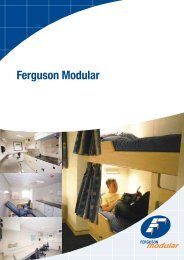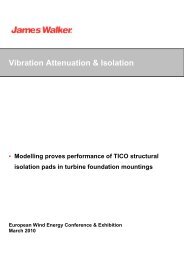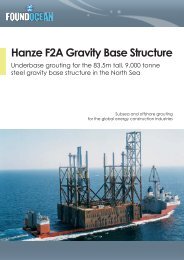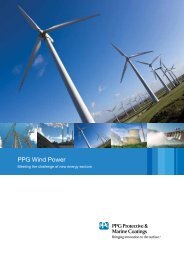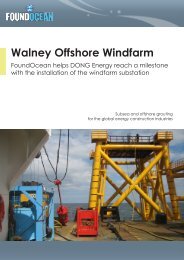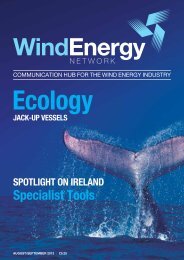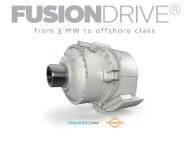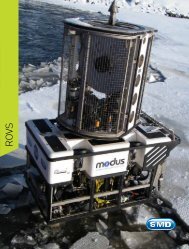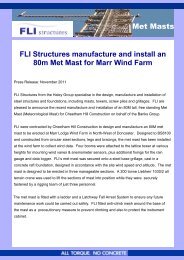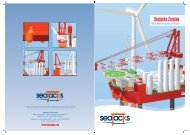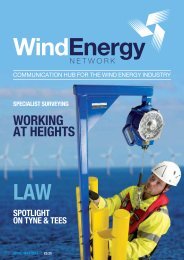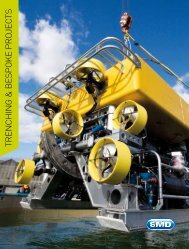UNEXPLODED ORDNANCE - Wind Energy Network
UNEXPLODED ORDNANCE - Wind Energy Network
UNEXPLODED ORDNANCE - Wind Energy Network
You also want an ePaper? Increase the reach of your titles
YUMPU automatically turns print PDFs into web optimized ePapers that Google loves.
SPONSORS OF Unexploded Ordnance<br />
Explosives<br />
Technology<br />
Blast Design take us<br />
through the process of<br />
the disposal of UXO<br />
Survey of Areas<br />
As per Crown Estate’s policy a sea bed<br />
survey is carried out up to 1km from<br />
any proposed offshore wind or tidal<br />
construction area or cable runs etc. As<br />
part of this survey they are looking for<br />
any UXO which in the North Sea would<br />
generally most likely be WW2 German air<br />
dropped ordnance or British.<br />
In many cases however the UXO can<br />
have become desensitised by salt water<br />
ingression and therefore the intention is to<br />
use the least NEQ (Net Explosive Quantity)<br />
in the donar charge to initiate the UXO.<br />
This way, if the UXO fails to detonate NEQ<br />
detonating in the water is experienced<br />
and the lowest overpressure from the<br />
detonation affects marine mammals.<br />
Step-by-step process<br />
An ‘as found survey’ is carried out by ROV<br />
which also includes a sonar sweep of the<br />
area – this is logged and saved for further<br />
use.<br />
Once any potential identified ordnance<br />
is found they carry out another ‘as found<br />
survey’ and the information gathered is<br />
detailed into a spreadsheet as follows...<br />
• Location on seabed to proposed<br />
development area, including coordinates<br />
– GPS waypoints<br />
• Possible type of munition,<br />
photographic evidence, still pictures,<br />
video, measurements.<br />
• Approx charge weight (by volume)<br />
then working out a max NEQ (Net<br />
Explosives Weight) as this is what<br />
will potentially cause any negative<br />
effects on marine mammals / existing<br />
pipeline / cables etc.<br />
• Water depth<br />
• Sediment / sea bed type<br />
• Munitions description<br />
• Potential diameter of crater that<br />
could be created and estimated<br />
released sediment<br />
• Safe range for marine mammals & fish<br />
• Injury range for mammals/fish and<br />
mortality rate – 25-40%<br />
• Lethal range for mammals & fish –<br />
mortality rate 75-100%<br />
• Distance to safety vessels/standby<br />
vessels/other third party DSV’s/MV’s<br />
etc<br />
• Owner of proposed offshore scheme<br />
• Specific Impulse on worse scenario<br />
detonation<br />
• Peak & over pressure based on worst<br />
scenario detonation<br />
Collation<br />
After the above data is collated and firmed<br />
up then the actual type/make of ordnance<br />
is established, the method of disposal<br />
is planned along with marine mammal<br />
/ fish mitigation procedures, third party<br />
safety distances, the technical design and<br />
deployment of the donar charge is then<br />
planned along with the Environmental<br />
Impact Study.<br />
Donar charge design<br />
A decision is made on the live explosive<br />
charge that will be used to initiate the<br />
found UXO – an assumption is made<br />
that the UXO is still live and capable of<br />
sympathetic detonation by a live initiated<br />
donar charge and on both the desktop<br />
assessment and the practical operation an<br />
estimate of safety distances is calculated.<br />
Successful destruction<br />
The aim is to sufficiently destroy the UXO<br />
so as to not leave any sizeable pieces on<br />
the sea bed which in future may still ‘look’<br />
like an UXO even though it may be a piece<br />
of inert casing.<br />
Unique design and firing system<br />
To achieve this criteria they use their<br />
own design of charge with a unique firing<br />
system.<br />
They use two conical shaped charges of<br />
approx 2kg NEQ each which directionally<br />
face each other with the ordnance in the<br />
middle. Basically a single conical shaped<br />
charge is a directionally functioning charge<br />
which produces a molten jet travelling at<br />
over 9,000m/s. If you were to place say a<br />
2kg conical charge with a 63* cone angle<br />
on top of a block of steel it would easily<br />
penetrate into the steel over 3ft-4ft.<br />
30<br />
www.windenergynetwork.co.uk



